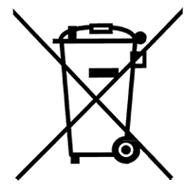WEEE
What is WEEE?
The Waste Electrical and Electronic Equipment Directive and the respective guidelines create a EU legislative framework strictly regulating the production, distribution and recycling of electrical and electronic appliances.
The objective of the Directive is to promote re-use, recycling and other forms of recovery of waste electrical and electronic equipment (WEEE) in order to reduce the quantity of such waste to be disposed and to improve the environmental performance of the economic operators involved in the treatment of WEEE. The WEEE Directive sets criteria for the collection, treatment and recovery of waste electrical and electronic equipment. The implementation of these European and country-specific laws and requirements is regulated on a national level.
Is WEEE the same in every European country?
No, the implementation of the EU directive is regulated at a national level.
Directives must first be transposed into national law in every Member State. This area is the more complex because of the fact that the Directive is under Article 175 of the EC Treaty, which allows Member States considerable freedom in their transposition into national legislation. As a result, the various national legislations differ substantially across Europe.
The Directive aims at providing for protection of human health and the environment. Due to fact that EC Treaty article 175 provides for a “minimum harmonization” measure, some Member States have chosen to put in place stricter measures. Plus, the responsibilities and obligations of producers, authorities, distributors, and all other parties are addressed within the framework of each country’s national law. As a consequence, producers have to consider the transpositions into national legislation.
What is the overall aim of the Directive?
The Directive aims to prevent or reduce the negative environmental effects resulting from the generation and management of WEEE and from resource use.
Its key purpose is to contribute to sustainable production and consumption by, as a first priority, the prevention of WEEE and, in addition, by the re-use, recycling and other forms of recovery of such wastes.
WEEE Legal Responsibility
If you manufacture, rebrand or import electrical and electronic equipment (EEE), you are a producer of EEE and need to comply with the Waste Electrical and Electronic Equipment (WEEE) Regulations.
WEEE Registration
Request for a WEEE registration via the local WEEE authorities.
WEEE Declaration
Submit a periodical WEEE declaration with the weight (and unit sales when applicable) of the products put on the local markets.
Keep records for at least four years.
WEEE Labelling
Label all new electrical and electronic products with the WEEE symbol (a crossed-out wheeled bin symbol).
How will Katun comply with the Directive?
In compliance with WEEE regulations, certain Katun products are labeled with the crossed-out garbage bin symbol. The WEEE bin symbol is used to identify products that cannot be disposed of as domestic waste and must be recycled. The details of the logo and other specifications regarding the nature and scope of the marking are defined in the European standard EN 50419.

WEEE Symbol
In compliance with WEEE Regulations, Katun has registered with local WEEE authorities in all countries where Katun has a fiscal entity. Katun provides regular periodical declarations to the local WEEE Authorities.
Katun WEEE Registrations Numbers:
| Country | WEEE Registration |
| DE | 52769177 |
| ES | Represented by Corpus Consulting & Service |
| FR | FR000056 |
| IT | Represented by Remedia Account number C008055 |
| NL | WEEENL0047 |
| PT | Represented by Corpus Consulting & Service |
| UK | Represented by Weecare; Weecare Account number 136066 |